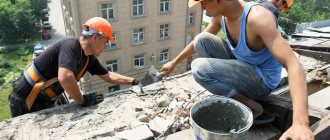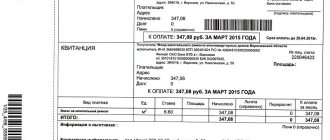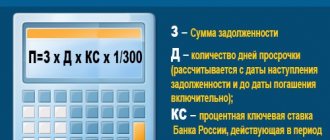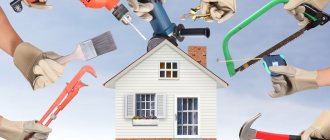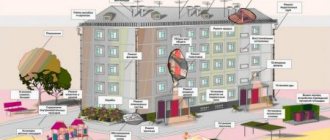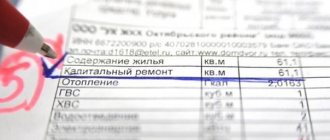Basic concepts and definitions
The payment for major repairs is the financing of a number of large-scale construction activities aimed at restoring the functionality of the apartment building as a whole..
Major repairs involve complete or partial replacement of building structures, strengthening balconies and foundations, eliminating cracks, replacing heating and water supply systems, and much more.
During its implementation, even redevelopment of residential premises can be carried out (without compromising the integrity of load-bearing structures).
Major repairs must be carried out in agreement with the owners of the premises . It is divided into two types:
- comprehensive - renovation concerns the entire building, carried out approximately once every 25 years;
- selective - the update concerns individual parts of the building, carried out approximately once every 15 years.
The line in the receipt “Maintenance and repair of housing” is the expenses of the apartment owner for managing the apartment building and repairs . In fact, this is payment for the services of the Management Organization and a source of financing for the necessary ongoing work. Do you need to pay such receipts for major repairs? Read here.
Payment for current repairs is the cost of smaller, compared to capital, construction activities aimed at maintaining the house in working order. Current repairs include restoration or replacement of entrance doors, windows, railings, improvement of staircases and local areas, and much more.
It is divided into two types:
- planned - the scope of work is determined based on inspection by specialists and identification of faults, carried out approximately once every five years;
- unscheduled - repair of minor, insignificant faults or elimination of emergency situations, carried out according to the established work schedule or immediately.
To distinguish between current and capital work, the following standards should be adhered to::
- more than 15 percent of the volume of the facility is subject to replacement - capital work;
- Less than 15 percent of the object's volume is subject to replacement - ongoing work.
IMPORTANT! To carry out a major repair of the roof of an apartment building, most of it must be faulty. Otherwise, replacement work will be considered ongoing.
What is a major overhaul?
The existing developed list of services provided is the basis for performing work of an ongoing nature. The list approved by Decree No. 290 of the Government of the Russian Federation [3] includes the scope of work and its frequency.
When calculating the housing and communal services tariff, the cost of each item in the list is calculated and the real tariff is displayed. All actions aimed at maintaining the proper level of maintenance of housing in a decent condition, namely the common areas of apartment buildings, fall into the category of current costs.
Other work carried out above the recommended list is work of a capital nature. Costs allocated by residents of residential buildings can be used for capital works for the following types of work:
- Complete roof repair.
- Insulation or restoration actions on the facade of a building.
- Replacement of elevator equipment.
- Complete replacement of pipes of any engineering communications.
- Restoring the functioning of the ventilation system heads.
- Replacement of windows and doors in common areas.
- Insulation of the attic floor.
- Installation and maintenance of common house metering devices.
The work planned to be carried out at the expense of the Capital Repair Fund is carried out by specialized construction organizations with the provision of initial estimates and certificates of completion of work. In turn, the action of the FKR is regulated by Section IX of the RF Housing Code[4].
The completed results of the action are presented for approval by the group of living owners. In case of obvious exaggeration of the cost of work or the volume of work performed, residents have the right to appeal the actions of contractors to the prosecutor's office, having previously been armed with acts of independent examination.
The difference between modern major repairs carried out after 2012 is that the cost of major repairs of the common property of the house used to be a concern of the state. Currently, homeowners, in addition to tidying up their apartments, also take care of the house as a whole by contributing money to the Overhaul Fund.
According to statistics, over the 4 years of the Federal Law, major repairs were carried out in more than 130,000 apartment buildings.
Legislative regulation of repair work
Legal relations in the matter of major repairs are regulated by Federal Law No. 271 of December 25, 2012, as well as the Housing Code of the Russian Federation.
The law clearly states the following points::
- who is obliged to pay for major repairs of apartment buildings (Article 169 of Federal Law 271);
- how to organize preparations for its holding (Article 189 of Federal Law 271);
- list of works related to capital (Article 166 of Federal Law 271);
- who sets the amount of contributions (Article 167 of Federal Law 271).
Everything related to current repairs is regulated by the Rules and Standards for the Technical Operation of the Housing Fund MDK 2-03.2003, separate articles of the Housing (Article 154) and Town Planning Codes of the Russian Federation (Article 55.24).
Benefits for paying contributions for major repairs in a new building
Not all homeowners must make contributions for major repairs in a new building and other buildings included in the program. Preferential conditions can be established both at the federal and regional levels. For example, in accordance with the changes made in 2016, municipal authorities received the right:
- exempt single pensioners who have reached the age of 80 from paying for capital repairs;
- provide a 50% discount to elderly people who have crossed the 70-year mark.
As for decisions at the federal level, the Housing Code of the Russian Federation provides for 50 percent compensation of the payment amount for persons with 1st and 2nd disability groups, disabled children and their guardians. Benefits were first provided to Muscovites, and were subsequently adopted in a number of regions of Russia.
Low-income citizens can also take advantage of the benefits. The state gives them the right to apply for a subsidy not only to pay for housing and communal services, but also for major repairs. To receive benefits, you must confirm that these payments exceed a certain share of the family budget. The same assistance is provided to large families.
Veterans and participants of the Great Patriotic War and labor, persons who were exposed to radiation and rehabilitated citizens have the right to take advantage of special conditions for contributions for major repairs.
Differences in receipts and payment methods for major and current repairs
Let's consider what is the difference in contributions for major repairs and routine repairs of residential buildings.
How to pay for major repairs?
- Contributions for major repairs are formed in a separate receipt and depend on the area of the apartment (from when they must be paid and how they depend on the area of the apartment, we described in a separate publication).
- According to the law of the Russian Federation, each subject sets tariffs independently (you can find out what the minimum contribution amount and the tariff for major repairs are here).
- The receipt indicates the recipient of the payment, the payer's full name, the address of the apartment, the number of square meters, as well as the personal account.
- These are monthly contributions.
The legislation provides for two options for raising funds . Apartment owners choose which one to use:
- The funds are paid into the account of the territorial Capital Repair Fund and subsequently allocated for a specific house, according to the approved plan.
In what year each house is subject to major repairs is decided by local authorities. In fact, it turns out that other people's houses will be repaired at your expense. The advantage of this payment method is the following: if your home requires repairs, the Foundation will pay for all necessary work in full. - A management company or HOA will open a separate special account for the house, into which the owners will pay fees.
All funds raised will be used to repair your specific home. However, if the money collected is not enough, the owners will have to pay extra on their own.
How to pay for current repairs?
- payment for current work is included in the receipt, located in the line - maintenance and repair of housing and depends on the area of the apartment;
- tariffs are set by the Management Company or HOA;
- payment is made monthly.
Funds from the column in the receipt “Maintenance and repair of housing” are transferred to the settlement account of the Management Organization . Part of this amount goes to pay for the labor of cleaners, plumbers, electricians, passport specialists, etc. The rest of the amount will be spent on ongoing repairs.
Contributions for major housing repairs: a little about their legal nature
I read the Federal Law of July 29, 2021 No. 257-FZ “On Amendments to the Housing Code of the Russian Federation” (hereinafter referred to as Federal Law No. 257), especially these changes to Part 3 of Art. 158 of the Housing Code of the Russian Federation: “The obligation to pay the costs of major repairs of common property in an apartment building applies to all owners of premises in this building from the moment the ownership of the premises in this building arises. When the ownership of premises in an apartment building is transferred to the new owner, the obligation of the previous owner to pay the costs of major repairs of common property in the apartment building, including the obligation not fulfilled by the previous owner to pay contributions for major repairs, is transferred to the new owner, with the exception of such an obligation not fulfilled The Russian Federation, a subject of the Russian Federation or a municipal entity that is the previous owner of premises in an apartment building .” It is also significant that they are given retroactive force: they apply to legal relations that arose from January 1, 2013.
Let's try to analyze what the political and legal meaning of the changes made is, especially taking into account the fact that the obligation to pay for housing and utilities is personal in nature. The owner's obligation to pay for residential premises and utilities arises from the moment the ownership of such premises arises (clause 5 of part 2 of Article 153 of the RF Housing Code), which is expressly stated in clause 26 of the resolution of the Plenum of the Supreme Court of the Russian Federation dated June 27, 2021 No. 22 “On some issues of consideration by courts of disputes regarding payment for utilities and residential premises occupied by citizens in an apartment building under a social tenancy agreement or owned by them by right of ownership” (hereinafter referred to as Resolution No. 22). The principle applies here: if you become an owner, you pay for housing and utilities; if you cease to be an owner, you don’t pay. With this approach, the creditor under the obligation to pay the fee (management organization, service provider) had to make demands on the previous owner, and the new owner would pay for his period. Since apartments were sometimes sold by marginalized individuals, it was difficult to get anything from them, and the interests of creditors suffered.
Therefore, at one time in the Housing Code of the Russian Federation, the obligation to pay the costs of major repairs, and then contributions for major repairs, was endowed with the property of following; the corresponding right of claim also acquired this property, which gave it to some extent proprietary features. True, the second mandatory feature of real rights – absoluteness – does not seem to follow from this formulation of the RF Housing Code. One can easily imagine a situation in which the collector of contributions for major repairs has changed, and the citizen, of course, should not lose the rights secured by previously collected contributions. If the new collector of contributions for major repairs has not received any of the funds collected by him from the previous one, the owner of the residential premises must still have the repairs made, as if all the contributions were available. Of course, it would be possible to give this owner the right to claim against the previous collector, but this is pointless. He still won't be able to get the money back. So it made no sense to give an absolute character to the right to pay for capital repairs. All the same, only one person will collect contributions and repair the living space. However, it is possible that in order to recognize an encumbrance as a real one, two signs of real rights are not required at once. The following property is sufficient.
According to clause 11 of Resolution No. 22, “payment for residential premises and utilities for the owner also includes a contribution for major repairs (clause 2 of part 2 of article 154 of the Housing Code of the Russian Federation). If contributions for major repairs are given the special character of a property encumbrance, then it turns out that parts of the same payment have different regimes. One part is endowed with the property of following, and the other is not. Of course, housing and maintenance organizations have long dreamed of giving all types of payments for residential premises the ability to follow, which now have to create artificial obstacles for sellers who have arrears in payments for residential premises and utilities. But for now, this difference remains, and this can be explained by the understatement that remained after the dispute about the nature of contributions for major repairs in the Constitutional Court of the Russian Federation. After all, payment for housing and utilities is made within the framework of ordinary civil obligations: a person, and not his things, is provided with some benefit for which he pays. There are no special grounds for recognizing the obligation to pay this payment as a real encumbrance.
By the way, it is useful to discuss the question of why it is necessary to talk about a proprietary encumbrance, and not about transferring a debt by force of law. The transfer of debt, in theory, should occur once, i.e. if the apartment is resold a second time, then there seems to be no basis for collecting the old debt that was still owed by the first owner. After all, both the assignment of a claim and the transfer of a debt are personal in nature. It is also unclear why the previous owner should be released from the obligation to pay arrears of contributions. He transferred ownership of the apartment by way of singular succession, determining its price taking into account the debt on contributions for major repairs, and, it seems, he owes nothing. The transfer of debt is tied to this succession, in contrast to a real encumbrance. And if there was no succession at all, what happened to the obligation to pay contributions...? Has it survived? Probably yes! In a word, the difference between a real encumbrance and a “revolving” transfer of debt still needs to be discussed.
However, it is unlikely that the legislator thought for a long time about the meaning that he put into the property of following the obligation to pay contributions for major repairs. Its purpose is to have the current owner pay the dues that any previous owner failed to pay. It would be much easier to declare these owners joint and several debtors. So let’s dwell for now on the fact that we are still faced with a proprietary encumbrance, consisting in the presence of a special public obligation. However, the owner’s obligation is not unconditional; it is subject to the statute of limitations, so contributions for major repairs after three years may no longer be considered payable. The need to make major repairs to one’s property, as part of the owner’s burden, does not cease with the expiration of the statute of limitations...
Contributions for major repairs are a way by which the owner bears the burden of maintaining his property, shifting it to other persons. With regard to them, there is no direct connection between the provision of a benefit and the payment of payment, that is, remuneration. Contributions can be made for dozens of years, the owner of the residential premises can change several times during this time, and the sums themselves will be spent on repairing other houses (unless they are accumulated in a special account) - and only after that there will be a counter-provision financed by, say, a public entity . At the same time, the owner is deprived of a choice - to repair his premises himself or make contributions for major repairs. The forced nature of these contributions, of course, infringes on the right of ownership of residential premises, and the time gap between major repairs and contributions gives the latter the property of a forced public legal fee, which is given the property of a property encumbrance. Payment for living quarters and utilities on this basis is fundamentally different from it.
The contribution for major repairs is precisely a public legal fee, and not an individual payment, the right to which is retained by a private individual. Since contributions may, in certain circumstances, be spent on major repairs to other houses, there is no obligation to maintain the appropriate amounts in the accounts of contribution collectors at all times. A similar situation occurs with respect to payments to state social funds (Pension, Social and Health Insurance Funds). Their deficit is periodically covered by the budget, since at the time of making contributions the size of the future payment is unknown and it is unclear when it should be made. Even if a citizen has the right to major repairs, he will have nothing but a bare claim not secured by property. In general, fees spent on the solidary principle cannot have individual remuneration, since there is no clear relationship between them and the reciprocal provision, and you can never claim exactly what you contributed.
If the contribution for major repairs is a public law fee, then the right to demand payment for major repairs belonging to the owner cannot be qualified either as a property right or even as a civil right. It would be strange if the owner’s burden became at the same time his property right. We can talk about the right only when contributions for major repairs were forced to be made to a third party, for example, to a regional operator. If the residential premises require repairs, which are not carried out within the established time frame, you can force them to do this through the court. True, it is unclear how the corresponding court decision will be enforced, since it will be necessary to repair the entire residential building, and not just one apartment. But, undoubtedly, a procedural solution will be found..., for example, for the time being until major repairs are carried out, the owner will be paid to rent a similar apartment. In other words, the right to pay for major repairs most likely has the nature of a special public law, according to which the regional operator is obligated, and in terms of payment for privatized premises that require repairs, the previous lessor, or more precisely, the owner of the lessor.
It is noteworthy that now the following property is not attached to the obligations of the Russian Federation, its constituent entities and municipalities to pay for major repairs in the relevant part. These responsibilities obviously continue to apply to these persons in relation to the period during which they were the owners of the premises. The new owners do not have to fulfill this obligation for them. Thus, the instruction of the Constitutional Court of the Russian Federation to the federal legislator to establish a mechanism for the fulfillment by the former landlord of the obligation to overhaul houses in need of it, which was provided for by Art. 16 of the Law of the Russian Federation “On the privatization of housing stock in the Russian Federation”. This mechanism is that public entities must participate in the financing of capital repairs of residential buildings in the relevant part, see paragraph 6 of the Constitutional Court Resolution No. 10-P of April 12, 2021. The obligation to participate in financing does not have the following property, remaining with the Russian Federation, its constituent entities and municipalities, but applies only to privatized residential premises in houses in need of major repairs. Moreover, most likely, this obligation is not subject to the statute of limitations.
Unfortunately, the law does not define the scope of the monetary obligation of public entities - the Russian Federation, its constituent entities, municipalities - to finance capital repairs of residential premises, nor the procedure for determining it. Of course, they have general competence to maintain the housing stock in the relevant territory in proper condition, but it is not enough. Public figures have so many responsibilities, it’s impossible to keep track of them all. So one can easily imagine a situation in which major repairs need to be carried out, but the regional operator does not have enough money. And nothing can be done except for the owners to “chip in” for repairs in the amount of the missing amount. True, if they do this, there is no mechanism in the law to force a public entity to cover the debt. Stalemate situation…
So, let's summarize. The owner of a residential premises is obliged to pay contributions for major repairs in the manner prescribed by law. This obligation, as well as the right to demand payment of contributions, has a public legal nature, although it is built on the model of a property encumbrance. The owner of a residential property also has a public legal nature to demand payment for capital repairs from the person to whom he made contributions. Moreover, no one freed the apartment owner from the burden of maintaining their property. This burden continues to weigh on him. And if it happens that there is no and will not be money for major repairs, the regional operator is insolvent, and nothing could be received from the relevant public entity for its debts in the form of subsidiary liability, the owner, despite paying dues, will be left alone with his dilapidated housing. Let us add to this that in the event of bankruptcy of a bank in which there was a special account where contributions for capital repairs were accumulated, the risks, as a rule, are also borne by the payers of the contributions.
At whose expense is it carried out and is it possible not to pay?
Both capital and current repairs are paid for by the owner of the residential premises. Contributions for major repairs are mandatory payments for the apartment owner. It is impossible not to pay them. A penalty is charged on the amount of the debt.
Where and how you can find out the amount of debt for major repairs is described here.
If contributions for major repairs are not paid, the Fund first sends notifications and then files a lawsuit against the owner to collect the debt . The line in the receipt for housing maintenance and repair is also mandatory for payment. Find out in this article whether it is mandatory for residents of municipal apartments, and whether the owner can refuse major repairs and not pay for it, read this article.
Major and current repairs differ in terms, methods and schedules of organization, and the scale of work. However, both of them are paid from the funds of the owners of the premises and are carried out to ensure their comfortable stay in the house.
Who has benefits
The right to compensate 50% of contributions for major repairs from the budget is granted to:
— Disabled people of groups 1-2, “Chernobyl survivors,” combat veterans, WWII participants and categories equivalent to them — they enjoy federal benefits for paying for major repairs, regardless of their place of residence.
In addition, the authorities of the constituent entities of the Russian Federation at their level provide 50% compensation for the cost of major repairs:
- homeowners who have reached the age of 70, do not work and live alone or with family members who are pensioners or non-working disabled people of groups 1-2,
- labor veterans and other categories of beneficiaries, the list of which is determined at the level of each region - therefore may vary depending on where a person lives.
The following have the right to 100% compensation of contributions for major repairs:
- non-working homeowners who are over 80 years old - provided that they live alone or live together with pensioners or non-working disabled people of groups 1-2 -
as well as Heroes of Russia, the Soviet Union, full holders of the Order of Glory and family members living with them .
But I would like to draw your attention to the fact that the above-mentioned compensations are calculated not from the actual amount of the contribution for major repairs, which is accrued to the beneficiary, but within the limits of the regional standard for the standard area of living space.
This standard is approved at the level of each subject of the Russian Federation, and therefore may vary depending on the region where the beneficiary lives.
For example, in Moscow this standard is 33 square meters. m for a person living alone, 42 sq. m for a family of two and 18 sq. m - for each family member, if there are three or more people in it.
Accordingly, an 80-year-old owner living alone is exempt from contributions for major repairs if the area of his home does not exceed 33 square meters. meters (for an area that exceeds this standard, you will have to pay fees).
